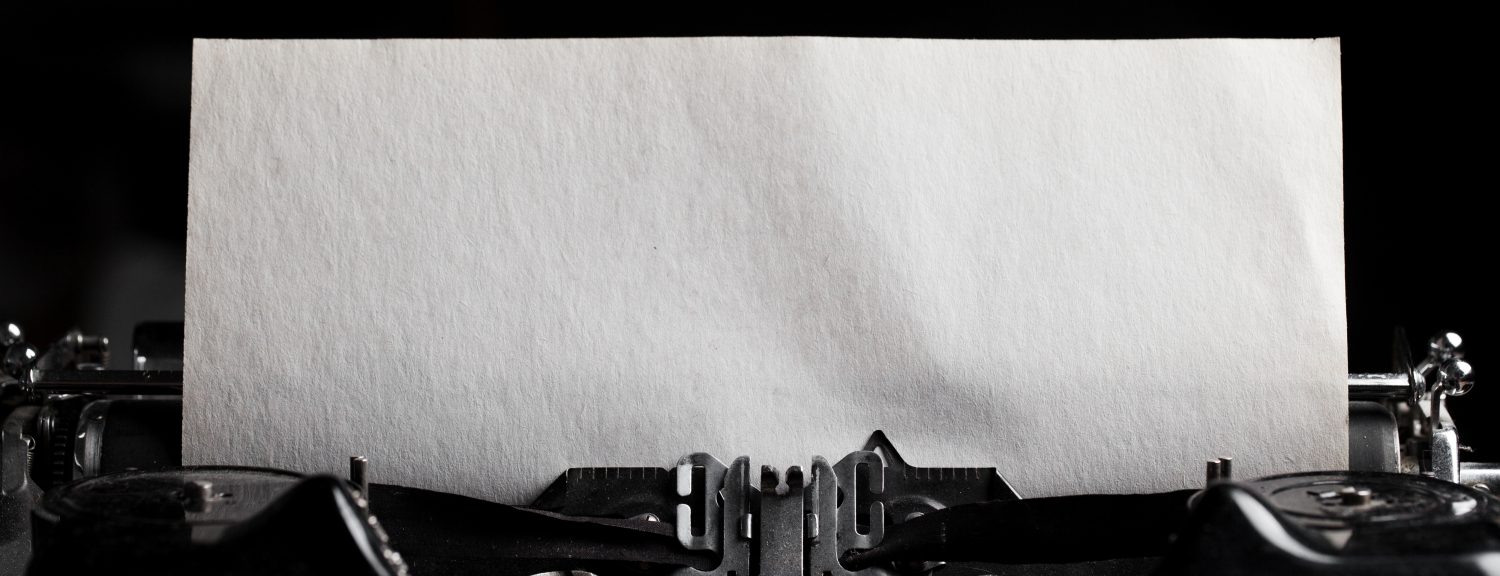Shallow Foundations
Note: Although this blog references The Rise of Skywalker, at this point I still haven’t seen it.
When you sit down to write a story, you create characters who’ll serve that story. They each have a unique function. Once that function is complete, the character is done. They exit the story.
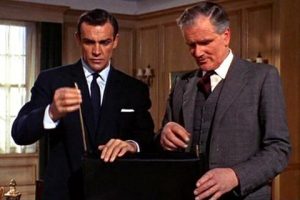
James Bond movies illustrate how characters function in self-contained stories. Bond’s boss, M, briefs Bond about his mission. Q will provide Bond with weapons and gadgets. Once M and Q have fulfilled their roles, their jobs are complete. In a few Bonds, M and Q might reappear, but usually never with any great depth, necessity, or regularity. There’ll be a villain, some allies, and a love interest. At the end of a James Bond movie, everybody resets for the next one. Then we do it all over again.
The Rocky series employs characters whose function changes depending on the story in which they’re operating. In Rocky (1976) and Rocky II (1979), Apollo Creed plays the antagonist, while Mickey plays the mentor. In Rocky III (1982), Mickey passes away. Apollo becomes the mentor. This is a good reflection of how we evolve and change throughout life. Creatively, Sylvester Stallone takes these supporting characters as far as they can go. When he can get no more out of them, he kills them off to provide new drama that Rocky has to deal with. The alternative is to retire unnecessary characters and write them out, the way Ryan Coogler wrote Rocky’s son, Robert, out of Creed (2015).
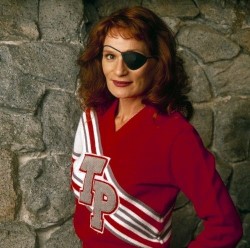
Series operate differently, because the story is continuing and evolving. The original Twin Peaks (1990 – 1991) series is another good example. Every character in that show was originally conceived to serve the story’s premise – the mystery behind the murder of Laura Palmer. Everybody revolved around that axis, and then forked into their own subplots.
Once the murder was solved, lots of these characters became redundant. The writers found things for them to do, but often in some baseless, disassociated role that was nothing more than filler – a way to justify the character’s continuing existence. Lots of the characters became aimless. Instead of the characters authentic choices driving the story, the story was trying to fit them any way it could to keep them relevant. The show struggled and was soon axed.
I was never confident that the Star Wars Sequel Trilogy would work because I believe The Force Awakens (2015) is appallingly constructed. It looks great. It echoes the beats of the Original Trilogy (a mandate from Disney to director JJ Abrams). It draws much from nostalgia, which (in my opinion) prejudiced people still wounded by the Prequels in its favour.
But that’s about it.
Characters are given roles without much function, motivation, and direction. Because of this, they don’t drive the story. The story determines wherever they need to be at any given time. The reality should be that the characters make choices, and those choices influence how the story unfolds. In Force, those paths are predetermined. The characters themselves aren’t well defined enough to create those pathways. You could put anybody in their places and the story would go exactly the same way.
This is not good character development.
Compare it to the movie that started this all: in Star Wars: A New Hope (1977), Luke lives with his uncle Owen and aunt Beru on a farm on Tattooine. They come into the possession of two droids: C3PO and R2D2. R2D2 contains the plans to the Death Star, and a message from Princess Leia to Obi Wan Kenobi. R2 tries to get to Kenobi, who lives nearby. Luke goes after him. Luke meets Kenobi. Imperial Forces who are trying to find the droids track them to Luke’s uncle and aunt, and murder them. With nothing left for him on Tattooine, Luke finds the motivation to fight the Empire and decides to join Kenobi and go to Alderaan. They charter a ship, flown by Han Solo and Chewbacca. The Empire has destroyed Alderaan, so when Luke and his company arrive they find only the Death Star waiting. The Millennium Falcon gets tractored in and Luke learns that Princess Leia is being held prisoner on the Death Star. Luke wants to do the right thing and save her. Han only joins in at the mention of money. They save her (well, she saves them). Following Kenobi’s sacrifice, they escape. The Rebels launch an assault on the Death Star, although Han doesn’t want to get involved on a personal or political level. During his trench run on the Death Star, Luke looks as if he’ll be shot down by Darth Vader. Han returns with the save. Luke blows up the Death Star.
This story could only unfold with these characters. Everything in this plot construction is logical. The only thing that happens by chance is Luke coming into possession of the droids – although that has a justification to it. Then everything tracks causally. Every action creates a new pathway. Each new pathway advances the narrative causally. The characters’ choices determine the shape of the story. Each of the characters serve this story to its conclusion – right up to Han Solo’s surprise return during the attack on the Death Star.
The Empire Strikes Back (1980) continues Luke’s story as he seeks out Yoda to learn the ways of the Force.
Now I’ll pause here to delineate the difference between chance and causality.
In The Empire Strikes Back, Kenobi charges Luke with going to Dagobah and seeking out the Jedi Master, Yoda. Luke crash-lands on the planet right next to Yoda. The story continues.
In JJ Abrams’ Star Trek (2009), Spock maroons James Kirk on a snow moon. A snow monster chases Kirk. Kirk flees and ducks into a cave, where he meets Spock Prime. The story continues.
What’s the difference here?
Luke is told to seek out Yoda. This is going to happen whether Luke crash-lands on Yoda’s doorstep, or on the other side of the planet. In the case of the latter, Luke might have to travel for three hundred hours, and have ten other movies worth of adventures before he gets to Yoda. Is that important to this particular story, though? No. So it’s skipped. We go right to Luke seeking out Yoda, just as he was told to do.
It’s like when characters find parking right outside their destination in movies. Convenient? Yes. Of course, the writer could write a scene where the character drives around the block for twenty minutes looking for parking, parks ten minutes away, then jogs to their destination, but is any of that needed to move the story forward? No (well, usually not). So it’s skipped to get to the next plot point – why they came to this location. That’s what’s advancing that particular story. Real-life conceits (like struggling to find parking) are dismissed when they’re irrelevant to the narrative’s progression, just as we don’t (usually) see toilet breaks, or characters flossing, or picking their nose, or anything that doesn’t advance the story.
In Star Trek, Kirk’s not told Spock Prime is on this snow moon. Kirk’s not told to run into that cave. It’s just fluke. If it wasn’t for this random encounter, the story couldn’t continue. Kirk would just be wandering around in the snow, not knowing what to do next. He can only move forward because he meets Spock Prime, and he only meets Spock Prime through chance. Chance drives the plot, which is lazy storytelling – especially when you look at the odds of being marooned on the moon in the vicinity of the one cave you would need to run into to meet the one character who can help you take the story to the next level. I might accept one chance encounter, or maybe even two, but when it keeps happening it screams of slipshod plotting, and characters being placed where they need to be our of contrivance, rather than causality.
In Empire, Han and Leia – besides developing a relationship – continue to serve the story. They are used as bait to lure Luke to Cloud City. He goes there and is accosted by Darth Vader. Although Empire breaks into two disparate story lines – Luke’s training with Yoda, and the Millennium Falcon fleeing the Imperial Fleet – they intertwine and then rejoin.
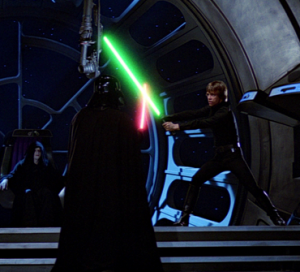
In Return of the Jedi (1983), Luke continues his story. This has been the drive behind the Original Trilogy – that Luke was the hope in the fight against the Empire. Regardless of how much the story was improvised along the way (e.g. deciding to make Darth Vader Luke’s father, and the reveal that Leia is Luke’s sister), the structure remains intact. It started with mystery in A New Hope, was expanded upon in The Empire Strikes Back, and comes to fruition in Return of the Jedi. Luke becomes a Jedi Knight and confronts Vader and the Emperor.
Leia, Han, and all the other characters are superfluous to that battle. And that’s what they become in Jedi. The writers have to find things for them to do: the attack on the shield generator on the Endor Moon, and the run on the new Death Star. But they’re insignificant because the real battle has always been about Luke, Vader, and the Emperor. Harrison Ford recognised that, which is why he requested that Han Solo be killed off. This whole part of the movie is filler – story created to try keep characters who’ve outlived their usefulness relevant.
Now look at The Force Awakens.
The story opens with Poe getting a map to Luke Skywalker’s whereabouts. This opening scene implies Poe – who is portrayed as dashing and courageous – will be the story’s protagonist. He programs the map into BB8 and sends him fleeing across the desert. Poe is then captured and brought up to a Star Destroyer.
On the Star Destroyer, Finn – a Stormtrooper trying to find a way to desert – sees Poe as an opportunity to escape. Okay, this is logical enough. Finn isn’t a pilot. Poe is. Finn thinks Poe can fly them both off the ship, so Finn helps Poe so that Poe can help Finn. They sneak into a TIE Fighter, flee, then crash land back on the planet. Finn gets off TIE Fighter, but a sinkhole swallows the ship. Finn assumes Poe has died and walks to the nearest town.
A pause: in A New Hope, George Lucas introduces R2D2 and C3PO. They’re droids – limited in what they can do and clunky. But they give us a clinical overview of the battle and the Empire’s power, before handing off the story to our protagonist, Luke Skywalker. In The Phantom Menace (1999), Lucas tries to use the same technique, but it becomes convoluted: we’re introduced to Qui Gon and Obi Wan Kenobi (who would seem our heroes), who meet Queen Amidala (wait, maybe she’s our hero), who then try to pass off the story to Anakin (is he meant to be our hero?). By this stage, we don’t know whose story Phantom belongs to, and its narrative shows that it’s unclear on that also.
As for Force, everything they show you about Poe would suggest he’s going to be your protagonist. But he disappears abruptly, then doesn’t show up again (unexpectedly) until much later in the movie. You could argue he hands off the story to Finn; Poe tells him about BB8 and the map, but in no way does Finn take that responsibility on himself. So Finn leaves the crash with no real goal, unlike Luke and Kenobi, who took on the responsibility of fighting the Empire once R2 had delivered the message; and Anakin, who joined Qui Gon and Obi Wan to meet the Jedi Council.
We also meet Rey, and are introduced to her scavenger existence. BB8 rolls across the desert and bumps into her. This is total chance. In all the desert, with no predetermination, and with no foreknowledge of each other’s existence, these two meet. Rey goes to town. Finn meets Rey. Again, this is chance.
Now consider this logically: in all the desert, BB8 just happens to meet Rey. In the whole planet, Finn just happens to crash land near Rey’s town, and then when he walks to that town, he just happens to meet Rey. So Finn just happens to meet Rey, who just happens to be in possession of BB8, which is a droid that just happens to belong to Poe, who Finn just happened to help escape. That bundle of chances forms the core of Force. None of this is driven by character. It just is – arbitrary positioning and re-positioning of the characters so the story can go where it needs to.
Surely it would’ve been more logical to make Rey an inhabitant of the village Poe visits at the beginning, or even the foster child of Lor San Tekka, who Poe meets about the map. When Kylo and the First Order Stormtroopers attack, she hides. She might hide with BB8. This spins off in interesting ways. As a survivor, she might have guilt that she hid. She might have motivation for revenge. That motivation could later play into her dark side of the Force temptation. This also gives her an immediate awareness of Kylo.
In Force, she stupidly (inexplicably) says to Han Solo that she thought the events of the Original Trilogy were myth – she knows of Han Solo the smuggler, but not Luke Skywalker and the the Empire’s overthrow. That’s some whimsical narrative that doesn’t make sense. I’d be more inclined to buy the latter if she saw the First Order at work, and thus never knew anything different. So many interesting possibilities could arise from grounding the character.
Nope. Here, chance drives the plot. This is unlike A New Hope, because R2 programs the escape pod to try land near Kenobi. When R2 is sold to Uncle Owen, R2 then tries to get to Kenobi. R2 knows where Kenobi is. Getting to Kenobi is programmed into R2. Kenobi is watching over Luke, so they live in proximity to one another. This is all purposeful.
In The Force Awakens, Poe has one objective: to secure the map to Luke’s location. That’s his entire purpose. He fails that. His character arc is actually done because we’re never told anything else about him. Compare that to Han Solo in A New Hope: he’s paid to take Luke and Kenobi to Alderaan, then is convinced there’ll be a reward – which plays into his character as a mercenary – if he rescues the princess. His actions are motivated. This all make sense. When he’s got his money, and despite Luke’s and Chewbacca’s protests, he decides to leave. But we know he’s started to soften. He asks Luke to come with him – they’ve developed a friendship. He muses to Luke earlier about Princess Leia, ‘Still, she’s got a lot of spirit. I don’t know, what do you think? You think a princess and a guy like me—’ When Luke cuts him off, Han smiles ruefully. He’s changed from the person we first met.
Poe simply reappears at the Resistance’s base, and explains to Finn that he was ‘thrown’ clear of the crash. How did this not kill him? How many people thrown clear of plane crashes survive? This ship’s not floating to the ground, but hurtling down. Finn parachuted out, so maybe Poe did also – in that case how did Poe eject from the TIE fighter but leave his jacket behind? People might consider these nitpicks, but they’re valid questions.
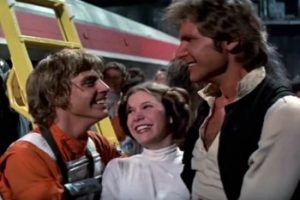
The two embrace as if they’re lifelong friends reunited. This is meant to mirror Luke and Han Solo’s embrace in A New Hope, but by this time in A New Hope the two have shared lots of adventures, Han’s just saved Luke from being shot down by Vader, and everybody is celebrating the destruction of the Death Star – this moment of reconnected friendship is believable. Then throw in the fact that Han surprised everybody by returning. Han even quips in a self-deprecating manner, ‘Well, I wasn’t going to let you get all the credit and take all the reward’, which shows that self-awareness that he’s changed. The audience would want to hug him at this point. This is also why we can believe he’s thrown in his lot with the Rebels come Empire. He’s been moved by the Rebels’ plight. Finn and Poe shared one adventure for about five minutes of screen time. The story is trying to force the fact that they’re awesome friends on us, rather than developing that friendship so we can genuinely invest in it.
Poe then needs to be rebooted as a character: he leads the attack on the Starkiller Base. Now his role is tantamount to Wedge Antilles – a peripheral character in the Original Trilogy who developed a cult following by virtue of surviving, but had no depth or development beyond that. Given Poe was charged with finding the map, surely his arc is to use the map to find Luke, or to go with Rey to find Luke. Oscar Isaac does a great job in such a limited role, but the story at no time has any idea what it expects of Poe outside of his opening scenes.
Finn’s entire objective is to escape the First Order. He does that. His arc is actually complete. That’s all he wanted. There could be an intelligent exploration of how he was taken as a child, and brainwashed and trained to become a Stormtrooper, but that’s left untouched. There could be an examination of why he is the one Stormtrooper to desert. Nope. Maybe he could even become an inspiration to other Stormtroopers who are contemplating deserting. Uh uh. He’s given nothing but a qualifier: he’s a deserter. That’s it. Later in The Force Awakens, Finn says he was stationed in Sanitation on the Starkiller Base. It feels as if the writers themselves are unclear on who Finn is meant to be.
Who he becomes is the exposition dump whenever the Resistance need information on the First Order. Finn provides key details about the Starkiller Base – how does he know this given his station was Sanitation? He provides vital information about the First Order’s tracking device in The Last Jedi (2017). How does a lowly Stormtrooper know all this? I’ve been at my workplace for over six years and couldn’t tell you where the electricity meter is. This is complex engineering. You could play on that and turn him into a tech wizard – that’s his talent and how he finds a purpose in life and a role in the Resistance. Given the Star Wars universe is filled with tech, you’d think this is a niche they could explore. They’ve never had tech geniuses, because technology is the purview of the droids. Uh uh.
Now it’s fine for some random character to be ensnared into a grander adventure – that’s been the plot behind lots of stories. But it’s never clear what Finn’s motivation is. Throughout Force, he constantly reiterates his fear. He’s used as a cheap misdirect to make us believe he’s Force-sensitive, when it’s actually Rey. Then, at the end – like Poe – he’s rebooted to help rescue Rey. It’s never really clear what he’s meant to be doing or where he’s meant to be once he deserts. Unlike Luke or Han, he has no investment in the story but continually tags along for two movies. He is an unintentional chameleon. He goes from deserter, to soldier, to Starkiller guide, to side-mission guy, to battling Phasma in a feud that has zero heat. He is just thrown wherever they need to generate screen time and keep him in the picture.
In The Last Jedi, both Poe and Finn are given pointless busy work. Does the story explore Finn’s origins? Or some motivation to free children being abducted into service of the First Order? Or to destroy the First Order’s training camps, and thus weaken their military? Or to ally with a hidden force of Stormtrooper deserters? Or to cause a Stormtrooper insurrection and destablise the First Order military? This is all interesting stuff that has relevance during war, but we get none of that. He’s still just scared. So he hasn’t developed at all.
Then he’s sent on a nothing side-mission, laden with all its own inconsistencies, absurdities, and chance encounters. Given the trilogy’s construction, shouldn’t stopping the First Order’s conscription of kids becoming Stormtrooopers be part of the plot? Apparently not. The Last Jedi simply tries to mirror Empire’s chase scene, and people are given roles around that – whether they fit or not. Most don’t. This is why new characters are introduced to parallel two of the characters who are meant to be our leads – they take roles that should’ve been part of Poe’s and Finn’s respective arcs. So now we’re getting more characters who are doing the work that our protagonists should be doing.
Poe is imposed with the arc of learning maturity. This is his entire story. Logically, given the way they’ve tried to frame this Sequel Trilogy around Rey, Finn, and Poe, Poe should be leading the escape from the First Order forces in The Last Jedi, which could’ve played as an interesting story – an inexperienced commanding officer must lead the fleet to safety. He makes mistakes, is challenged by others who would assume authority, but finds a way through, and is set up to take command in Episode IX. Instead, he never gets practical experience.
He confronts the First Order fleet replete with ridiculous, ill-conceived humour (why the First Order don’t just blast him out of space is anybody’s guess), and then is reprimanded by Leia. Despite obviously having seniority (evidenced by the fact he eventually takes over), he’s not included in discussions about the retreat – you would think everybody would be entitled to know the Resistance’s plans to save their lives (unless they’re keeping that information private because there’s a double agent in their midst – a truly interesting plot possibility, which is why I guess they didn’t use it). Later, when Luke shows up to combat Kylo in The Last Jedi, Poe deduces that Luke must be stalling to allow them to escape. Why wouldn’t Luke tell them he’s going to stall so they can escape? Why does Luke just go out and do his thing and let the others puzzle out what they’re doing next? This whole story relies on characters not advancing the most basic yet necessary information so that others – allies – can make informed decisions. Who operates like this? (The answer isn’t ‘military’ – in the Resistance, they’re all military.)
The antagonist, Kylo Ren, remains the same indecisive volatile brat throughout the story. Darth Vader has an arc in the Original Trilogy: he’s introduced as this bastion of evil in A New Hope; furthers that in The Empire Strikes Back, but then introduces his ambition to usurp the Emperor, and a sprinkling of humanity in wanting his son by his side; and then in Return of the Jedi his son’s emotional plea reaches him and he kills the Emperor (sigh).
Kylo? In The Force Awakens, he gets upset and shouts a lot. In The Last Jedi, he gets upset and shouts a lot. He has some connection to Rey which is never explained or developed outside of it existing. To facilitate it, Snoke (well, Rian Johnson) invents a way the two can communicate across the vast reaches of space (if Force-wielders are capable of this, it would’ve been a useful way for the Jedi to communicate when the Empire was eliminating them). Kylo then kills Snoke, and it’s meaningless. Nothing changes. Kylo plays it all like Anakin in Attack of the Clones (2002) – a lovesick teen prone to the occasional tantrum. Anakin is a lovesick teen, though. Kylo isn’t. This is a character whose descent into the Dark Side should be complex and meaningful, tantamount to the Joker’s decline in Joker (2019). And then instead of making him the all-powerful villain, The Rise of Skywalker introduces Palpatine so Kylo can be redeemed, although there’s no genuine motivation as to why Kylo would redeem himself – as Vader/Anakin did – outside of this connection we’re told he has with Rey. Like with Fin’s and Poe’s reconnect, we’re expected to believe this exists because we’re told it exists.
Rey is the only one who has anything close to functionality in the story. There’s a mystery teased about who she is. That’s it. The story doesn’t build on her. In the Original Trilogy, the story continually builds Luke, and the revelation that Darth Vader is his father is another building block in regards to the stakes, but which shifts Luke’s motivation from destroying Vader to redeeming him. In the Sequel Trilogy, Rey’s whole purpose hinges on who she is. Rian Johnson dismisses it all in The Last Jedi and says she’s nobody.
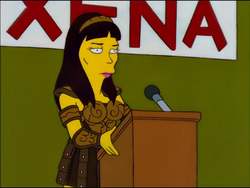
Then JJ Abrams comes back in The Rise of Skywalker (2019) and reversions it. Has it actually made any difference? We know she’s the protagonist because the stories keep positioning her that way, but we never truly understand why. It’s groundless. This is not character development. It’s character context. That’s it. The Palpatine reveal is also meaningless because it doesn’t provide genuine motivation, and it can’t provide retrospective motivation. He was never foreshadowed, so we’d have to rewatch those movies to apply our new understanding to what’s going on. Also, claiming Palpatine is behind everything is tantamount to the episode in The Simpsons (1989 – ) where Lucy Lawless is addressing a group of dubious fans and explains away plot inconsistencies in Xena: Warrior Princess (1995 – 2001) as, ‘A wizard did it.’
As for the Original Trilogy characters, not one of them has a genuine arc. Leia is just an older Leia. Han is back to being a smuggler. Their relationship has fizzled. People claim this makes Force darker and grittier, because it shows life doesn’t always work out. Maybe. But it seems more likely that the writers sat around suggesting ideas that the audience wouldn’t expect, and hadn’t been covered in Star Wars novels (whose canon Disney has since abandoned – that should’ve been a warning in itself). A likelier truth is they were re-positioned closer to their Original Trilogy models as part of Force‘s plot rehashing. Luke, though, is the opposite of what he was. He’s embittered. The man who denied the Emperor’s solicitations and successfully redeemed Darth Vader decided it was too hard, gave up, and fled to Ahch-To (but more on this in a bit).
The term ‘subverting expectations’ is popularly thrown around for these narrative choices. These stories aren’t doing what the fans expect, and that’s a good thing. Well, yes, if the story is still logical and causal within the parameters of its own universe. Fight Club (1999) subverts expectations. The Sixth Sense (1999) subverts expectations. The Empire Strikes Back subverts expectations. But these stories did so through complex characters pushed to extremes and compelling storytelling. With Empire, who complains that any of the characters are represented uncharacteristically or that they’re mistreated? These complaints are leveled en masse at The Last Jedi (even by Mark Hamill). Who complains that the plotting is shoddy? Check YouTube for countless logical and analytical deconstructions of why the plotting doesn’t work. The Last Jedi‘s narratives choices take the least likeliest course for shock – if not schlock – value because the audience doesn’t expect it. It’s cheap heat – tantamount to a pro-wrestler deriding the town in which the show’s appearing that night so they can get a boo out of the crowd. The qualification ‘subverting expectations’ is a fancy cop-out.
The Sequel Trilogy was built on ideas – a dashing pilot, a deserter, and a scavenger. A Stormtrooper who deserts does sound like an interesting character, but they’ve done nothing with it. A dashing pilot is a formulaic character, and they’ve done nothing to make him interesting. All they’ve impressed upon him is impetuosity. These are characters who are given no depth, no purpose, no respect in terms of development, and are constantly shuffled to keep them occupied while they try to work out how to position Rey next – as if it matters. She’s just moved to wherever the story needs her to go. Then she just continues to succeed and succeed and succeed. There is no tension or drama in anything she does because she is never genuinely challenged. There are masses of people who haven’t connected to any of these characters (which is also evidenced by poor merchandising sales – rumours abound of warehouses packed with toys that can’t be moved).
What makes Han’s return in A New Hope so special during Luke’s trench run is the story depicts Han as a heartless mercenary interested only in money. There’s a subversion of expectation, but a logical one given the friendships and bonds he’s formed. That’s why it’s a heartwarming and satisfying and surprising moment. The Sequel characters are too one-dimensional to expect anything from. They’re never developed beyond scattered concepts. That’s who they remain – shadows who don’t have enough substance to drive the story out of its derivation and pallor. It lacks genuine voice. The Prequels aren’t great movies, but they do have an authentic voice behind them. The Sequels look and sound like Star Wars, but they’re only Star Wars inasmuch as cover bands are the band they’re covering.
This Trilogy was never going to work. I understand people like it. I don’t understand how.
It desecrates legacy characters; is horribly, horribly plotted (I honestly don’t know how anybody finds it defensible given how often chance drives the storytelling – it threatens the sanity of the editor in me – or they invent tech and abilities or change canon to push the story where they need it to go); and the characters are paper-thin. I went into watching these movies wanting to like them because of my investment in this universe. I want to switch off and be taken on an adventure. Star Wars has always been magical. As ridiculed as the Prequels are, at least they still contain magical moments. None of that exists in the Sequels. When I sat down to watch, immediately things began puncturing my suspension of disbelief.
I generally watch these sorts of movies with a couple of friends. One said he was excited when he sat down for The Force Awakens. Then we got the logo: LUCASILM. Next, the preface: A long time ago in a galaxy far, far away. Then the music hit. He said his excitement was soaring. And then the text crawl: Luke Skywalker has vanished. That deflated him instantly. (I tried to hold on, but the issues built up. I finally gave up when Rey and Finn ran to the Millennium Falcon, which just happened to be sitting there – imagine that: the most popular ship in Star Wars just happens to be sitting there, ready to use, for these two characters who’ve never had any connection to the Original Trilogy characters.)
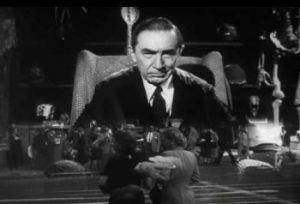
That text crawl is such a simple thing, but it’s always done a lot of the heavy lifting in this universe. In this case, just four little words – so carelessly chosen – derail a whole franchise empire because they betray the truth of this universe: Luke Skywalker is a hero. I’ll accept that he could turn into a bitter old prick if I can see it happen and believe it’s happening, but all the important stuff in The Force Awakens happens off-screen: Snoke rallies the remnants of the Empire into the First Order; the First Order abduct children, brainwashes them, and trains them to become Stormtroopers (this seems a much more time-, energy-, and cost-prohibitive process than just cloning an army); the First Order builds the Starkiller base; they replenish their fleet; Snoke converts Ben Solo; Ben Solo and the Knights of Ren slay the other Jedi apprentices, and Ben becomes Kylo Ren; and Luke, who redeemed Vader from a lifetime of evil, decides handling Ben Solo’s darkness is too difficult, and gives up.
So Luke Skywalker vanishes.
These four words are a misnomer, a throwaway that foreshadows a fireworks display of throwaways that are dazzling fleetingly, but fade to nothing.
If Luke doesn’t want to be found at all (as The Last Jedi clearly shows) why would he leave any trace to his location? If he plans to return, why would he leave a map at all and not just return when he’s ready? How does this motivation behind the map work? So Luke leaves, goes off to do whatever he was going to do, but leaves a map so he can be fetched and told, ‘Hey, we need you’? I do this often at work when I want a holiday. I tell my bosses I’m off, but I’m leaving a map to where I am, so when they eventually need me they can come get me. I apparently have no control over that decision. If Luke didn’t leave the map, who did? If it was map simply to the first Jedi temple, and everybody knew Luke was going there, who hid the map? So many questions.
The reality is when JJ Abrams and co were writing Force, they felt whenever Luke appeared he took over the story, whereas they wanted to transition to the next generation of characters. That’s fine. They should’ve then come up with a solution that made sense, e.g. Luke was examining the identity of Snoke, and had vanished. Luke hadn’t left a map behind – instead, he’d told Lor San Tekka he would be going to Planet X to investigate the rumours of Snoke’s origins. And that’s the last anybody heard of Luke. Poe goes to visit Lor San Tekka to get that destination, since Luke was operating under the radar. Poe gets the information, and sticks it in BB8 before being captured. The First Order don’t want Luke’s location (because perhaps they’re holding him captive frozen in carbonite) but to eliminate all trace of it so he can’t be rescued. All this is now being driven by the characters. The characters and their choices and desires have created narrative pathways that now make sense.
But we don’t get any of that. Instead, it’s just a map, so it mirrors R2D2 carrying the Death Star plans in A New Hope. And it’s a map to explain Luke’s absence in the most superficial way possible and to give the opposing sides something to fight over for one movie. After Force, it’s forgotten. When Rey finds Luke in The Last Jedi, Luke has changed so much that Mark Hamill himself refers to the character as ‘Jake Skywalker’, Luke’s cousin. Luke has exiled himself and cut himself off from the Force. While Rey is on this planet, Snoke facilitates communication between Kylo and Rey, yet never sees that Rey is standing near Luke. Remember, in Force, finding Luke is THE THING for everybody. The First Order desperately want him. And yet now he’s standing right there and Snoke can’t see him, or doesn’t question what Rey’s doing on this planet, or anything you would expect him to do. Instead, Snoke decides to go all Mills & Boon to create this relationship between Kylo and Rey. Why would Palpatine want this relationship?
Nobody worked this out. Nobody examined why the characters were making the choices that they do. Nobody outlined where these characters were going over three episodes. Again, its just moving pieces around to fit what they want to do for the sake of doing it, and not a bit of it makes sense, or has any real depth behind it.
But it looks pretty. And has a franchise empire behind it.
And that fools people into thinking it’s good.
I guess that’s all that matters nowadays.
